As was decided by popular vote in last week’s poll, today I bring you the theme of DT and bridges!
You’ve probably been wondering – how can bridges be dark? Well, in many quite different ways, as you will see. I’ll give you seven examples, starting with this one:
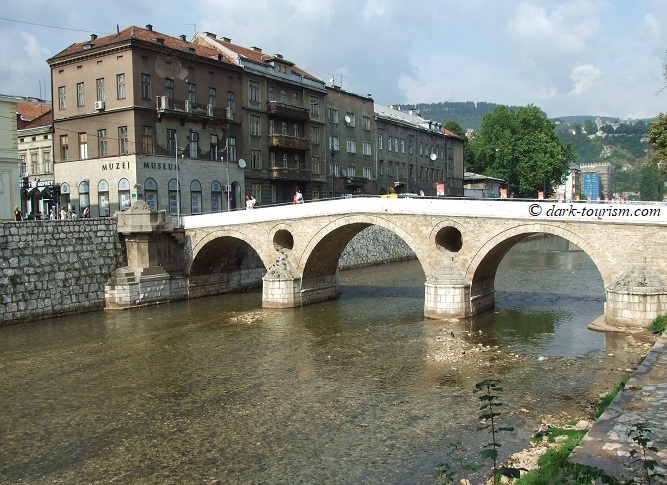
This is the oldest bridge in this batch – it’s the Latin Bridge in the Bosnian capital Sarajevo. The construction of the bridge goes back to Ottoman times, to the late 18th century, but its dark association is with a significant event that took place at the northern end of the bridge on 28 June 1914: the assassination of Archduke Franz Ferdinand, the Austrian heir to the Habsburg Austro-Hungarian Empire’s throne, and his wife Sofie. The incident subsequently sparked off World War One!
During the Yugoslav era the bridge was actually renamed “Principov most” after the name of the Bosnian Serb assassin, Gavrilo Princip! It reverted to the older name after the break-up of Yugoslavia and the Balkans wars; likewise the memorial plaque at the site is now a more neutrally worded one (in the local language and English). Just behind the bridge you can also spot the small museum that is about the Habsburg era in Bosnia and the assassination in 1914.
While the Latin Bridge’s association with a dark event was purely coincidental (the bridge itself is quite innocent), sometimes a bridge can be the cause of tragedy itself, namely when it collapses and drags people to their deaths. Here’s a particularly infamous example:
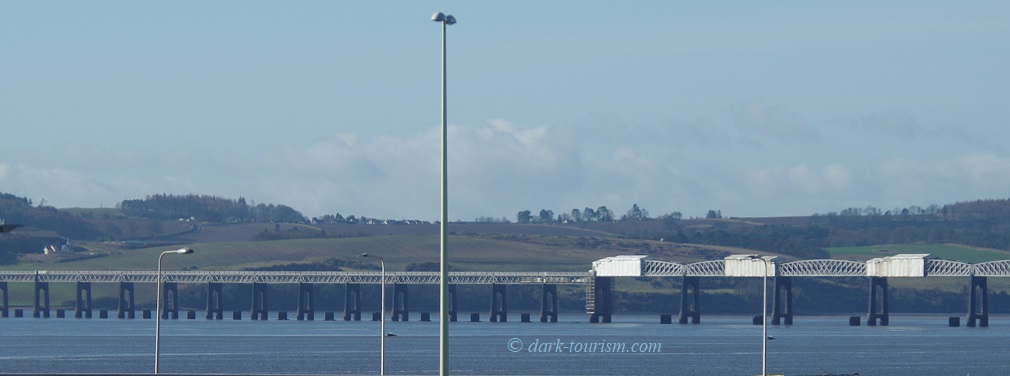
This is the site of the Tay Bridge Disaster of 28 December 1879. The railway bridge crossing the Firth of Tay at Dundee in Scotland had been in operation for only 19 months when on the evening of that day strong winds brought down a section of the bridge’s central span … just as a passenger train was crossing it. The train with all its carriages plunged into the cold waters and all 57 on board the train perished. It still stands as the worst bridge-related railway disaster in British history. The cause of the disaster had basically been a carelessly “light” design of the bridge that simply hadn’t factored in such strong winds. So it was also in part a man-made disaster.
The old collapsed bridge was soon after replaced by a sturdier, dual-track railway bridge that was inaugurated in 1887 and has since been carrying trains across the Tay without incident. This second bridge is the main thing you see in the photo above, but if you look closely you can see a row of stumps poking out of the water in parallel to the bridge – these are all that remains of the disaster bridge. You have to know what you’re looking at, but then these stumps make for a rather unusual dark-tourism sight!
Of course, many other bridges have collapsed too over history, some in dramatic fashion, even quite recently – like the Morandi Bridge in Genoa, Italy, which collapsed in August 2018 killing 43 people. But normally the ruins are demolished and taken away, so nothing remains to serve as a reminder of the disaster. In most cases a new bridge takes over its ill-fated predecessor’s role. In remote areas, however, sometimes disused and partially collapsed bridges can be found that are simply left in their unusable state, like this one:
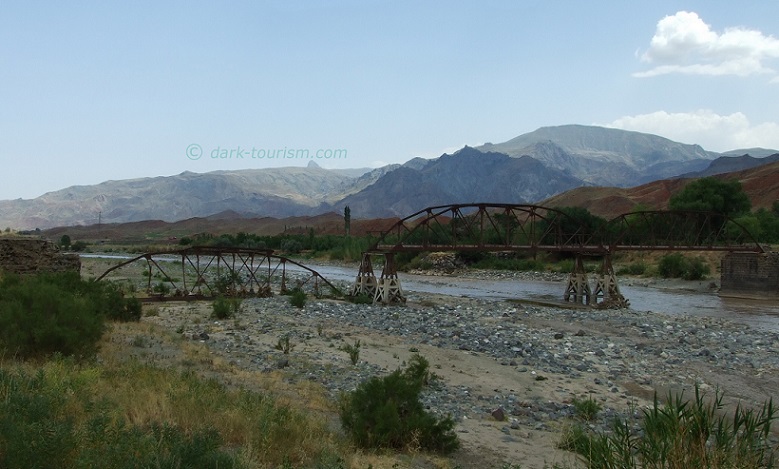
This is a partially collapsed bridge across the Aras Nehri river in a remote corner of eastern Anatolia, Turkey. I passed it by chance when I was driving in the area on my way from Mt Ararat to Kars along the D080 road and across a road bridge parallel to this one. I have no idea when this happened, whether anybody got hurt, or what caused the bridge’s collapse … probably just structural failure after years of disuse, going by the rusty state of the metal. But it was a rather atmospheric little surprise find on that trip in August 2007.
I’m glad, though, that I went to the far-eastern parts of Anatolia back then. These days some of the places I saw are no longer quite so easily visitable (safely and legally) by independent travellers, especially in Kurdish territories. And in the worrying current political climate in Turkey Kurds have fared badly and “security” restrictions have been tightened, especially of course near the southern borders with Iraq and Syria.
The next bridge featured here has not collapsed but is located in a land that many would regard as dark in itself: North Korea.
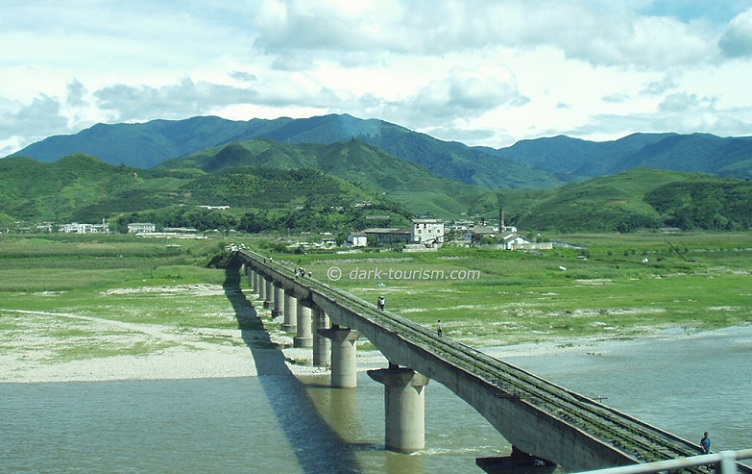
I spotted this bridge, also a long time ago, in 2005, on my organized group tour (one of only a couple of such “communal” tours I’ve ever been on) to the DPRK. That abbreviation stands for Democratic People’s Republic of Korea, and as with some other countries that feature the word “democratic” in its name in reality it’s anything but (the old GDR was another example). North Korea is widely regraded as the quintessential “rogue state”, thanks to its repressive regime of the Kim dynasty and its nuclear sabre-rattling policies.
The ultra-communist country is also an enigma, and that makes it a most exotic travel destination. Contrary to what some people imagine, it is actually quite safe to go there, at least as long as you don’t behave stupidly and start stealing things or insulting the “great/dear/supreme leaders” (Kim Il-sung, Kim Jong-il, and current #3 Kim Jong-un). The level of propaganda in this crazy place is often mind-boggling and in itself quite something to experience.
Of course, North Korean tour guides (perfectly trained and with fluent English!) try to show foreign tourists only what they consider to be the best sides of the country. But when being driven by bus through the countryside you see other aspects too, as it’s impossible to keep up a consistently shiny veneer outside the prime sights. And so you also get glimpses of industrial and agricultural decline and the poverty of ordinary countryfolk. This image is in fact an example of that. To begin with, note the crumbling and disused factory in the background. Trains, for which this bridge originally had been built, are also absent, and hence people use it confidently as a pedestrian bridge instead.
While some bridges are ‘dark’ because of collapse or dis-/misuse, sometimes a perfectly ordinary looking bridge can be very dark indeed due to the history of its construction, as in the next example.
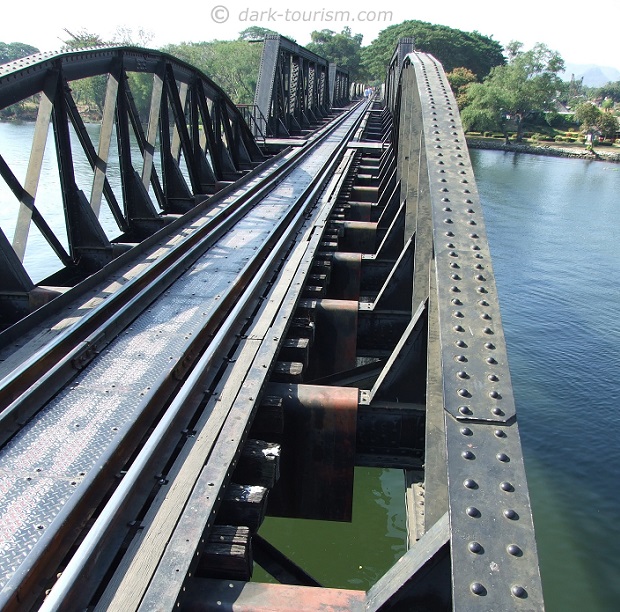
This is the (in)famous Bridge on the River Kwai, the real thing, looking quite different from the fantasy bridge that featured in the classic movie of the same name from 1957. That contraption looked more like a bamboo version of the Firth of Forth Bridge near Edinburgh in Scotland. The actual Kwai bridge in Thailand is a more mundane steel bridge, but its history is significant and very dark indeed.
The bridge was built as part of the construction of a train line to Burma, hence officially Thailand-Burma Railway, but it’s become better known as the Death Railway. That’s because Imperial Japan during WWII used tens of thousands of POWs for forced labour in the construction of the Death Railway, including many Australians, Brits, Dutch and Americans. Working and “living” conditions were incredibly harsh, the Japanese treatment of the workers brutal and the climate and diseases took their toll too. Many thousands did not survive this ordeal (including nearly 7000 Brits).
Today, several memorial museums commemorate the Death Railway, the best I found was the Australian one at Hellfire Pass, while some in the town of Kanchanaburi, especially the one right next to where the famous bridge is, can be rather shoddy. In town, the best option is the Thailand-Burma Railway Centre at the war cemetery (also a state-of-the-art Australian outfit).
The railway line itself is in part still in use, and you can ride a train north from Kanchanaburi to the end of the line. It’s quite a touristy affair, though, which can clash a bit awkwardly with the feeling of dark history at these sites. The same is true for the Bridge – where fiddlers haplessly try reproducing the famous theme tune of the movie and a little tourist train does nothing but cart visitors back and forth across the bridge. But you can also walk it … note, though, the absence of any health-and-safety regulations, so take care where you place your feet and look out for those trains crossing the bridge (that’s when you have to step off the rails and take refuge in those little side niches in between sections).
Moving on to the post-WWII Cold-War era, here’s another relatively plain smallish steel bridge, but one that is probably the most legendary of all bridges of that era: Glienicke Bridge.
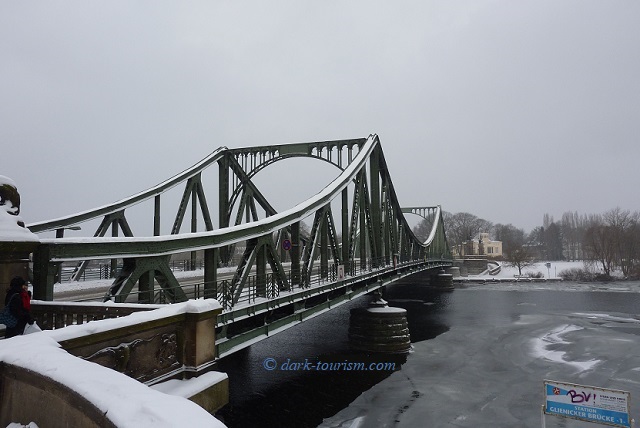
This comparatively inconspicuous bridge, connecting the south-eastern end of Berlin with Potsdam in Brandenburg, was once one of the busiest in Germany, but after WWII it ended up right on the border between the American sector of West Berlin and the Soviet-occupied Zone (what later was to become the GDR) that surrounded the enclave that the western part of Berlin had become. So the bridge became part of the front line of the East-West confrontation of the Cold War, an element of the Iron Curtain, as it were, and as such was normally impassable and heavily guarded.
However, what made Glienicke Bridge the stuff of legends is the fact that it was chosen by the opposing Cold-War-era superpowers as the location for spectacular exchanges of spies. This even gave the bridge the epithet “Bridge of Spies” in popular culture – although it was only on three occasions that such exchanges took place. The first one was on 10 February 1962, when US pilot (and CIA agent) Francis Gary Powers, who had been shot down in his U2 spy plane over the Soviet Union in 1960, was finally released … in exchange for top KGB spy Rudolf Abel, who was handed back to the Soviets … he had been key in passing on secret details of the USA‘s atomic bomb programme to the USSR. The third and last exchange, also the one involving the largest number of persons, took place in 1986.
So Glienicke Bridge, though much less visited by tourists (owing to its rather way-off location), is a significant part of Berlin‘s rich Cold-War-era heritage, on a par with Checkpoint Charlie and the few remnants of the Berlin Wall. The photo above was taken during the harsh winter of January 2010 – hence all that snow and ice.
Finally, I give you one of the most famous and celebrated bridges in the world, but one that also has a dark side …
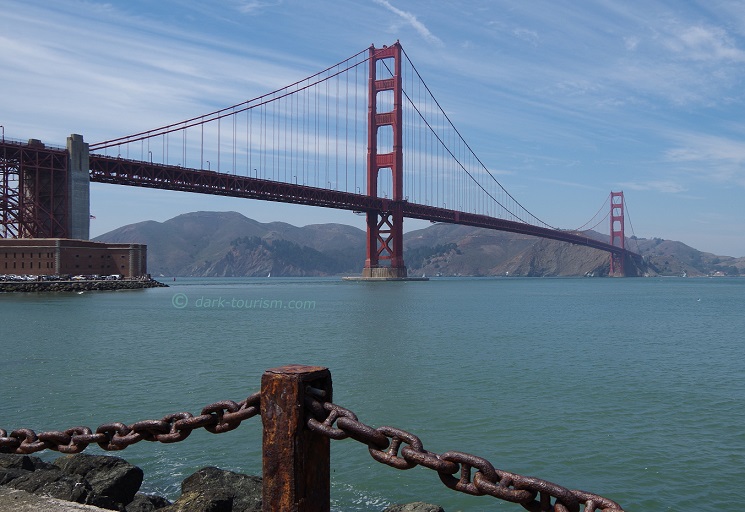
This beautiful and highly iconic structure is of course the fabled Golden Gate Bridge in San Francisco, California, USA. And what’s its dark secret? This very deadly one: it’s one of the world’s top suicide hotspots. Thousands have jumped off this bridge to end their lives, how many exactly is impossible to tell, but some 1600 bodies were recovered. Yet many others will have drifted out into the Pacific with the tide never to be found.
As a place to top oneself and simply vanish, this was an almost ideal spot. The height of the bridge, 70m above the waterline, more or less guarantees death on impact through fatal trauma, given the velocity a body would gain during such a long fall (which likely also causes unconsciousness before impact) – and the cold waters and the tide would take care of the rest (provided the suicidal person timed it right). Remarkably though, there have been a couple of survivors as well!
Measures to counter the attraction that this bridge obviously has for people intent on topping themselves have included free suicide crisis hotline telephones installed on the bridge’s pedestrian walkway, also regular patrols, both official and by volunteers, with the aim of preventing jumpers from actually taking “the plunge”. One local hero is on record for having prevented at least 30 suicides by talking (or wrestling) down the persons about to jump. Ironically, this celebrity suicide-stopper was called Ken Hopper!
Meanwhile steel safety netting is being installed at the bridge as a “suicide barrier”, scheduled to be completed by 2021. While it may not make suicides 100% impossible, it should markedly reduce case numbers.
Despite all that tragedy and death associated with the bridge, it is undeniably such a beauty. And I have to admit that I particularly like this photo – especially for the rusty chain in the foreground kind-of subtly echoing the shape of the famous bridge behind it. That’s why I also used it as the lead photo at the top of this post.
And speaking of photos: I found it rather ironic that after a Germanwings plane’s co-pilot committed suicide by crashing the plane into the French Alps (taking everybody on board with him to their deaths) in March 2015, media reports about the pilot (who had been hiding psychological conditions from his employer) regularly featured a photo or selfie of him posing in front of the Golden Gate Bridge. Did nobody in the media make the association with the bridge’s dark legacy and deem the photo somewhat inappropriate?
Anyway, this concludes this week’s “DT and bridges” theme. Seven Bridges were featured … and some readers who know a bit about vintage German pop music may be reminded of that kitschy song “Über sieben Brücken musst du geh’n” (‘seven bridges you have to cross’), originally released in 1978 by the GDR pop band Karat, but better known in the West in the 1980 cover version by Peter Maffay. It’s a pathetically pathos-laden ballad that once you know it is hard to get out of your head no matter how much you may despise it. When I saw that I had seven bridge pictures lined up for this post, the song’s chorus with that title line kept haunting me for days, even though I hadn’t actually heard the track in almost four decades …

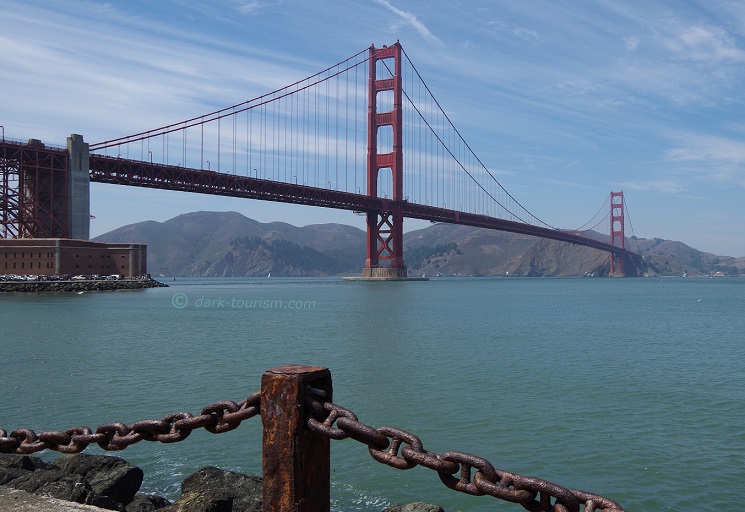



2 responses
The Tay Bridge Disaster was the topic of what’s widely regarded as one of the worst poems in English – take it away, William McGonagall:
https://en.wikipedia.org/wiki/The_Tay_Bridge_Disaster
The Golden Gate is one of the few structures which includes a statue to a structural engineer, in this case, Joseph Strauss, who oversaw construction of the bridge and who died almost exactly one year after the bridge was opened:
https://www.loc.gov/item/2013630018/
The first tunnel north of the Golden Gate (on Highway 101) is named in honor of Robin Williams, who, sadly, committed suicide:
https://www.theverge.com/2015/7/3/8889097/robin-williams-tunnel-san-francisco-marin-county
thanks for the extra info!